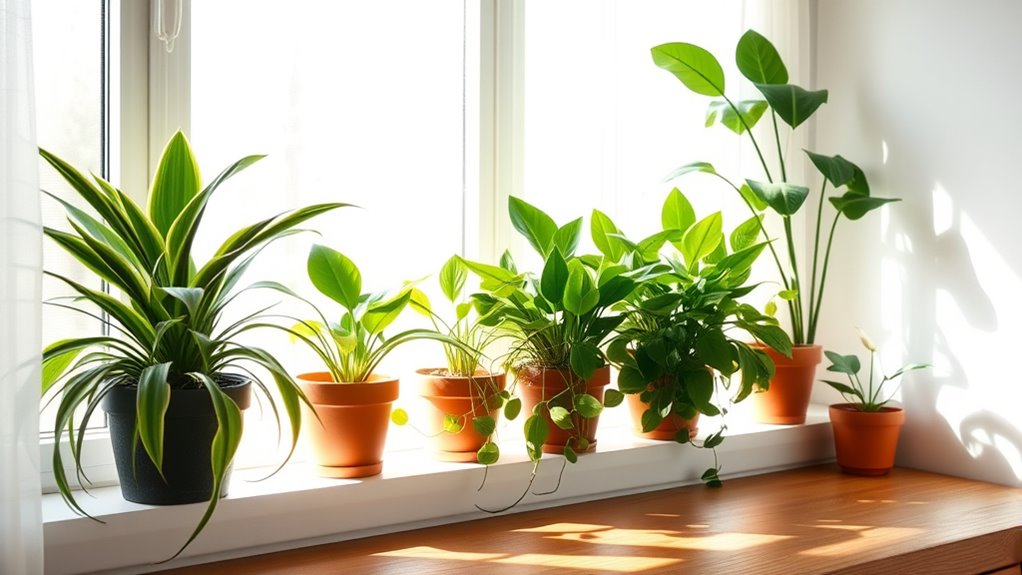Houseplants can improve your indoor space’s aesthetics and boost your mood, but their ability to markedly purify the air is often overstated. They can remove some toxins like formaldehyde or benzene, but usually not enough to replace air filters or ventilation systems. Proper plant care keeps them healthy and more effective, but don’t expect them to eliminate all indoor pollutants. To discover the truth behind houseplants and air quality, continue exploring the facts.
Key Takeaways
- Houseplants can improve indoor air quality but have minimal impact on removing toxins like formaldehyde or benzene.
- Proper plant care and maintenance are essential for plants to effectively contribute to air purification.
- Common houseplants like pothos or spider plants are often overstated; plants like snake plants are more effective and easier to maintain.
- Houseplants should be viewed as a supplement, not a replacement for ventilation or air filtration systems.
- Beyond air quality, plants offer psychological benefits such as stress reduction and aesthetic enhancement.

Indoor air quality can considerably affect your health, and luckily, houseplants offer a natural way to improve it. Many people believe that adding a few plants around the house can notably filter out toxins and purify the air. However, there’s a lot of misinformation about how effective houseplants truly are, especially when it comes to air purifying myths. It’s easy to buy into the idea that just having a couple of popular plants, like pothos or spider plants, will dramatically clean your indoor environment. The truth is, while plants do contribute to better air quality, their ability to remove toxins like formaldehyde or benzene in a typical home setting is often overstated. Studies have shown that the impact of houseplants on indoor air is minimal compared to proper ventilation and air filtration systems. So, don’t rely solely on plants to solve indoor air quality issues—think of them as a complementary addition rather than a complete solution.
If you decide to bring plants into your space, knowing the plant maintenance tips is vital to keep them healthy and effective. Healthy, thriving plants are more capable of filtering the air, but neglecting their care can lead to dead or unhealthy plants that do little good. To maximize their benefits, ensure your plants get enough light—most thrive in indirect sunlight—and water them appropriately, avoiding both overwatering and underwatering. Regularly wipe their leaves to remove dust, which can block their ability to photosynthesize and take in air pollutants. Also, be mindful of the type of plants you choose; some are better suited for indoor air purification and require less maintenance, such as snake plants or peace lilies. Keeping your plants free from pests and diseases not only prolongs their lifespan but also guarantees they continue to contribute positively to your indoor environment. Additionally, understanding the psychological benefits of having greenery can enhance your overall well-being, as studies suggest that indoor plants can reduce stress and improve mood.
Understanding the truth behind air purifying myths helps you set realistic expectations for what houseplants can achieve. They won’t replace your HVAC filters or air purifiers, but they do add a touch of natural beauty and can improve humidity levels and mental well-being. Remember, proper plant care is vital for their health and your enjoyment. Follow simple plant maintenance tips to keep your greenery lush and vibrant, and don’t rely on them as your sole method for cleaner air. Instead, see houseplants as a delightful, natural enhancement to your home environment—a way to boost mood, add aesthetic appeal, and complement other air quality measures. By combining realistic expectations with proper plant care, you’ll enjoy the many benefits houseplants can offer without falling for common misconceptions.
Frequently Asked Questions
Can Houseplants Eliminate All Indoor Air Pollutants Completely?
You might wonder if houseplants can completely eliminate indoor air pollutants. While they can help improve air quality, they aren’t perfect air purifier alternatives. Proper plant placement strategies, like placing them in high-traffic or polluted areas, boost their effectiveness. However, to truly improve your indoor air, consider combining houseplants with other methods, such as ventilation and air purifiers, for a healthier environment.
How Many Houseplants Are Needed to Significantly Improve Air Quality?
To substantially improve indoor air quality, you’ll need several houseplants, typically one per 100 square feet, depending on plant type and placement. Focus on strategic plant placement around your space to maximize air exchange rates. Keep in mind, plants alone won’t eliminate all pollutants, but they can contribute to cleaner air when combined with proper ventilation. Regularly rotate and care for your plants to maintain their air-purifying benefits.
Are There Any Houseplants That Are Safe for Pets and Children?
When choosing houseplants, you want pet safe plants and child-friendly greenery to keep everyone safe. Some great options include spider plants, areca palms, and Boston ferns, which are non-toxic to pets and children. Always double-check plant labels or consult a reliable source before bringing new greenery home. This way, you enjoy the benefits of houseplants without risking your loved ones’ safety.
Do Certain Houseplants Produce More Oxygen Than Others?
You might wonder if some houseplants produce more oxygen than others. The answer is yes—plants with higher plant efficiency, like snake plants and areca palms, generally generate more oxygen. Their ability to produce oxygen depends on factors like leaf size and photosynthesis rate. While all plants contribute to indoor air quality, choosing those with better oxygen production can enhance your space’s freshness and your well-being.
How Often Should I Care for My Houseplants to Maximize Air Purification?
Think of your houseplants as silent air purifiers that thrive with a steady routine. You should water them according to their needs—usually once a week—and stick to a consistent fertilization schedule, about once a month. This care maximizes their ability to filter toxins and improve air quality. Avoid overwatering or over-fertilizing, as both can stress the plants and reduce their purification power. Consistency is key to keeping them healthy and effective.
Conclusion
So, next time you’re convinced that a few houseplants will transform your toxic fortress into a lush oasis, think again. Sure, they look cute, but don’t rely on them to save you from indoor pollutants. If you really want clean air, maybe consider opening a window or investing in a real air purifier. After all, your tiny fern isn’t a miracle worker—just a tiny green decoration pretending to be one.









